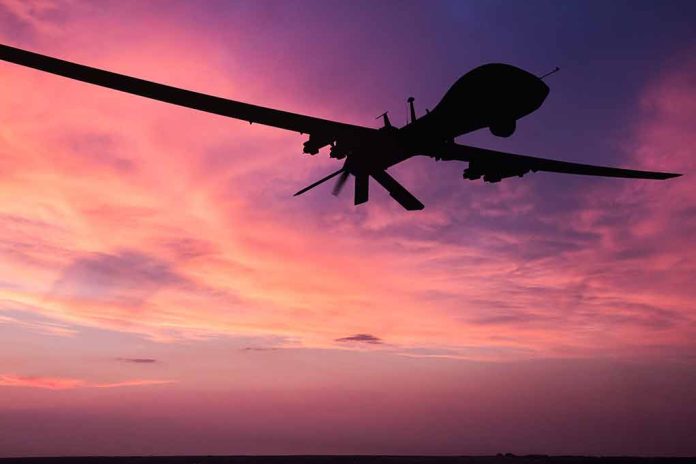
America’s defense policies are dangerously unprepared for drone attacks, with military experts warning that policy gaps—not technology—leave the homeland vulnerable to the same devastating tactics Ukraine recently used to destroy 41 Russian aircraft.
Key Takeaways
- Ukraine’s recent drone attacks destroyed 41 Russian aircraft, demonstrating how low-cost drone warfare can devastate military assets worth billions.
- U.S. homeland defense has critical policy and authority gaps that prevent effective response to drone threats, not technological limitations.
- Military experts warn it may take a major drone attack on American soil before necessary policy reforms are implemented.
- Potential threats include foreign actors and domestic extremists, with concerns about 3,000 potential hostile agents already in the U.S.
- An “all-hands-on-deck” approach involving federal, state, local governments, private industry, and research institutions is needed to address vulnerabilities.
Ukraine’s Drone Success Exposes U.S. Vulnerabilities
Ukraine’s recent devastating drone strikes against Russian airbases have demonstrated a new reality in modern warfare—one that exposes alarming gaps in America’s homeland defense policies. The precision attacks destroyed or damaged 41 Russian aircraft, including strategic bombers, by employing relatively inexpensive drones against high-value military assets. This asymmetric warfare approach has proven remarkably effective in the ongoing conflict, with both Russia and Ukraine establishing dedicated drone units and Ukraine planning to produce 10 million tactical drones annually.
The success of these operations was celebrated by Ukrainian leadership as a triumph of strategic planning and execution. “An absolutely brilliant result, a result achieved solely by Ukraine. One year, six months, and nine days from the start of planning to effective execution,” said Volodymyr Zelenskyy, Ukrainian President.
Policy Failures, Not Technology Gaps
Military experts emphasize that America’s vulnerability to similar drone attacks stems primarily from policy and authority failures, not technological limitations. Colonel Seth Krummrich, a former Green Beret commander, bluntly assessed the situation: “Interestingly, it is not a technological gap, it is a policy/authority process to engage and deny drone attacks. I assess it will take a major drone strike in the U.S. to change policy.”
“If a similar drone-based attack were launched on U.S. soil, it would be extremely difficult to intercept once set forth in motion, much like the events of 9/11,” said General David Grange, a retired U.S. Army General and former commander of the First Infantry Division.
The challenge is particularly acute for civilian operations, which face significant hurdles in obtaining the necessary authority to intercept drone threats. Current policies create bureaucratic obstacles that prevent quick responses to fast-moving drone incursions, which can reach speeds of 35 mph or more. This leaves critical infrastructure, military installations, and populated areas exposed to potential attacks.
Multiple Threat Vectors
The drone threat to America isn’t limited to foreign adversaries. Military experts point to a disturbing array of potential actors who could deploy drone attacks, including China, North Korea, Iran, and domestic extremists. General Grange described Ukraine’s drone operations against Russia as a “textbook example of asymmetric warfare” that could be replicated by America’s enemies. Even more concerning are reports suggesting that up to 3,000 potential hostile agents may already be in the United States, potentially able to deploy consumer drones for attacks.
“The future is soldiers hiding in holes underground while the drones fight it out above them,” one Ukrainian soldier grimly predicted about the future of warfare.
Recent mysterious drone sightings in the Mid-Atlantic region, particularly near military installations, serve as a troubling reminder of our vulnerabilities. These incidents, along with the Chinese “spy balloon” episode, highlight the need for President Trump’s administration to implement a more robust and proactive defense posture against these evolving threats.
Comprehensive Reform Needed
Addressing America’s drone defense vulnerabilities will require sweeping policy reforms that cut through bureaucratic red tape and establish clear chains of authority for drone countermeasures. Military experts emphasize that detecting drones is less of a challenge than having the proper policies and authorizations in place to take immediate action. Without these reforms, America remains dangerously exposed to the same tactics that Ukraine has employed so effectively against Russia.
“Solving this challenge will require an all-hands-on-deck approach: federal, state, and local governments must work hand-in-hand with private industry, research institutions, and technology developers to close the gaps in our homeland defense posture,” said David Grange, general.
The lessons from Ukraine’s innovative drone warfare campaign are clear – America must adapt its defense policies to address this new reality before experiencing a catastrophic attack on home soil. The technology to counter these threats exists, but without the policy framework to deploy it effectively, we remain vulnerable to enemies who are already studying Ukraine’s playbook.





